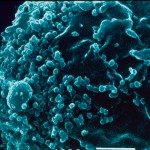Link to Pubmed [PMID] – 12100996
Biochim. Biophys. Acta 2002 Aug;1564(1):57-65
The human immunodeficiency virus type-1 (HIV-1) fusion peptide (FP) functions as a non-constitutive membrane anchor that translocates into membranes during envelope glycoprotein-induced fusion. Here, by means of infrared spectroscopy (IR) and of various bilayer-perturbation assays, we describe the peptide conformations that are accessible to its membrane-bound state and the transitions occurring between them. The peptide underwent a conformational transition from a predominantly alpha-helical structure to extended beta-type strands by increasing peptide concentration in 1-palmitoyl-2-oleoylphosphatidylglycerol (POPG) vesicles. A comparable transition was observed at a fixed 1:100 peptide-to-lipid ratio when calcium was added to vesicles containing prebound alpha-helical peptide. Cation binding induced an increase in the amount of H-bonded carbonyls within the interfacial region of POPG. Calcium-promoted alpha–>beta conversion in membranes correlated with the closure of preformed lytic pores and took place in dispersed (nonaggregated) vesicles doped with poly(ethylene glycol)-lipid conjugates, showing that the conformational transition was independent of vesicle aggregation. We conclude that the target membrane conditions modulate the eventual structure adopted by the HIV-1 FP. Conformational polymorphism of the inserted peptide may contribute to the flexibility of the fusogenic complex during the fusion reaction cycle, and/or may be related to target membrane perturbation at the fusion locus.



